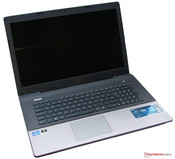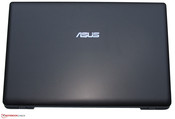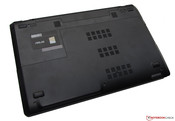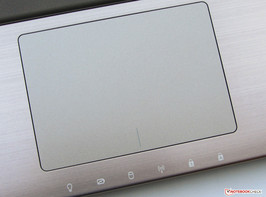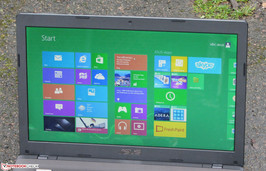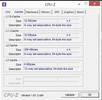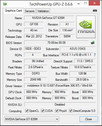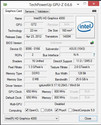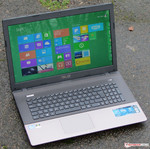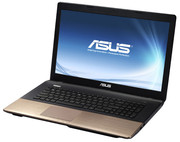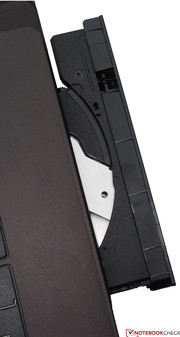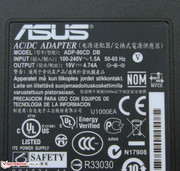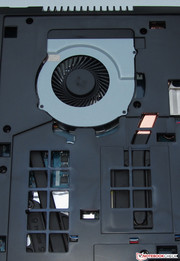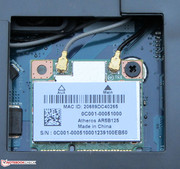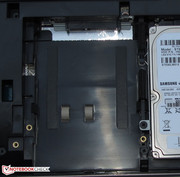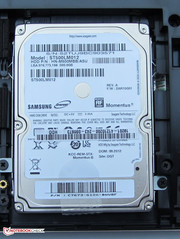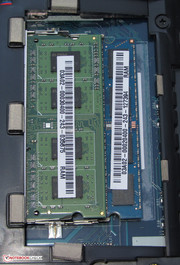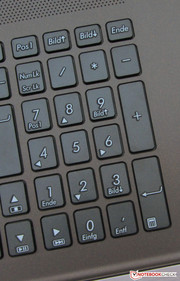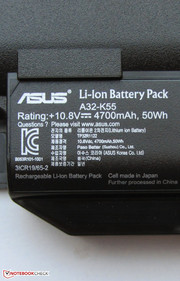Review Asus K75VJ Notebook

For the original German review, see here.
Asus want to attract buyers with a Core i7-3610QM CPU, a GeForce GT 635 GPU and a 17-inch display (1600x900 pixels). Given the specs, the device should be appropriate for nearly all fields of application and many users. Our tests will show if this is actually true.
We will compare the test sample to Lenovo's IdeaPad G780 (Core i5-3210M, GeForce GT 630M) and HP's Pavilion g7-2007sg (Core i7-3612QM, Radeon HD 7670M).
Case
We already know appearance, choice of colors and materials from the Asus K55VM-SX064V (15.6-inch). Except from the metal palm rests the K75VJ is entirely made from plastic. We appreciate that all parts of the case are matte. In addition, the lid has a surface texture which improves the grip. On the contrary, the case of the Pavilion is completely made from glossy plastic. Alike the Asus, Lenovo also mainly made the IdeaPad from plastics, but used metal palm rests.
The palm rests of the K75VJ are quite pressure resistant, but the other parts of the base unit are not that stable. The case slightly gives left and right of the keyboard. If you hold the base unit on one of the two front corners, the case slightly twists, but overall the stability is acceptable. The opened lid can also slightly be twisted and you'll observe a minimal color shift on the display, while it only slightly yields without recognizable image shifts under pressure. The hinges hold the lid stably in the adjusted position, but allow a minimal teetering. However, they are too stiff for one handed opening.
Connectivity
Communication
Contrary to the Pavilion and the IdeaPad, which only deliver Fast Ethernet, the K75VJ houses a Gigabit Ethernet chip (RTL8168/8111) from Realtek. The WLAN module of our test sample stems from Atheros (AR5B125) and supports standards 802.11 b/g/n. A Bluetooth chip is not available, but an HD web cam is incorporated into the display frame.
Accessories
In the box of the notebook the users will find a few thin guides, the warranty information and a short guide to Windows 8.
Operating System and Recovery
Asus delivers the 17.3-incher with pre-installed Windows 8 (64 Bit). An installation DVD is not included, but the notebook offers a recovery system. In order to launch it, you need to hit F9 after switching the computer on.
Maintenance
RAM, hard drive and WLAN module are accessible via a maintenance flap on the underside. In addition it is possible to clean the fan to some extent. The two RAM slots of our test model are already occupied (6 GB). The notebook supports up to 8 GB. It's easy to replace the hard drive. You simply need to loosen some screws and pull it out. Beside the hard drive there is also a second hard drive slot. So, you could equip the laptop with two hard drives: a fast SSD for the operating system and a conventional hard drive for the data. Unfortunately, a second hard drive cage is not included.
Warranty
Buyers of the K75VJ get a 24-month Collect and Return warranty. The IdeaPad also comes with a two year warranty, but the Pavilion's is only 12 month. It is possible to enhance the warranty period of the Asus notebook to 36 month for about 70 to 80 Euros (~$91 to $104), but you need to buy and enable this warranty extension within 90 days after the purchase of the notebook.
Input Devices
Keyboard
We already know the chiclet keyboard of the K75VJ from the K55VM-SX064V. The main keys are 15 x 15 mm big. The key travel is medium and the feedback noticeable. As you type, it is only a little bit springy in its center. Unfortunately, Asus wastes a lot of space which could have been used in favor of a bigger keyboard. The keys of the numeric pad especially appear a little bit cramped. Here it gets obvious that the test sample uses the same keyboard as its 15.6-inch counterpart.
Touchpad
Asus equip the K75VJ with a 10.5 x 7.4 cm touchpad. More precisely, they use a Clickpad, i.e. a touchpad without dedicated mouse buttons. So, the whole pad is always clicked and a right click is recognized upon clicking in its lower right section. The pad has a short travel, an audible and palpable feedback and a lot of space for multi-touch gestures, which can be enabled and disabled in the configuration menu. The smooth surface features pleasant gliding traits.
Display
Asus equip the K75VJ with a glossy 17.3-inch display with a native resolution of 1600x900 pixels. Other models are not available. The average brightness of 212.7 cd/m² is mid-range. The display of the IdeaPad G780 (220.2 cd/m²) is only marginally brighter, while the Pavilion's (172.7 cd/m²) is significantly darker. Furthermore, the distribution of brightness of 77% is not especially good. In this aspect, the HP (88%) and the Lenovo (91%) perform better.
| |||||||||||||||||||||||||
Brightness Distribution: 77 %
Center on Battery: 189 cd/m²
Contrast: 242:1 (Black: 1.03 cd/m²)
54.7% AdobeRGB 1998 (Argyll 3D)
75.2% sRGB (Argyll 3D)
52.9% Display P3 (Argyll 3D)
The brightness of the display from Samsung suffices for outdoor use, but you should avoid too bright a place. Because of the glossy display and the low contrast it will get difficult to read anything from the display.
Performance
Asus' K75VJ series consists of a number of general-purpose DTR notebooks. Their performance more than suffices for usual tasks like internet browsing and communication and video playback. Thanks to its GeForce GPU the laptop can also run demanding 3D games. We test the current top model of the series, which costs about 800 Euros (~$1045) at the time of writing. In addition, Asus also offer two further models of the K75VJ product range with different CPUs, RAM and hard drive capacities, which are priced at about 700 Euros (~$914, TY100H) and 750 Euros (~$980, TY101H).
Processor
Asus equip our K75VJ test model with an Intel Core i7-3610QM quad core Ivy Bridge CPU, which uses a base clock of 2.3 GHz. Its Turbo can increase the clock rate to 3.1 GHz (four cores), 3.2 GHz (two cores), or 3.3 GHz (single core).
In the Cinebench benchmarks the laptop scores as expected. The CPU works at maximum speed (3.1 GHz) and, because of its faster CPU, our test model significantly outperforms Lenovo's IdeaPad G780 (Core i5-3210M, GeForce GT 630M) and HP's Pavilion g7-2007sg (Core i7-3612QM, Radeon HD 7670M) in the CPU tests. However, the Pavilion is fastest in the GL test as it houses the strongest GPU of the three competitors.
| Cinebench R11.5 - OpenGL 64Bit (sort by value) | |
| Asus K75VJ-TY102H | |
| Lenovo IdeaPad G780 (M843MGE) | |
| HP Pavilion g7-2007sg | |
| Medion Akoya P7815-MD98063 | |
| Acer Aspire V3-771G | |
| Cinebench R11.5 - CPU Multi 64Bit (sort by value) | |
| Asus K75VJ-TY102H | |
| Lenovo IdeaPad G780 (M843MGE) | |
| Medion Akoya P7815-MD98063 | |
| HP Pavilion g7-2007sg | |
| Acer Aspire V3-771G | |
System Performance
The system works smoothly without stuttering and Windows 8 boots quickly. The total result in the PC Mark 7 benchmark confirms our subjective experience. The result of the K75VJ is nearly on par with the Pavilion's (Core i7-3612QM, Radeon HD 7670M). Both notebooks perform notably better than the IdeaPad (Core i5-3210M, GeForce GT 630M), which is equipped with a weaker dual core CPU with limited clock rates. Thanks to its fast SSD the Aspire V3-771G is significantly faster than its competitors (see figure).
| PCMark 7 Score | 2601 points | |
Help | ||
Storage Solution
A 5400 rpm 500 GB hard drive from Seagate's Momentus series is used as the mass storage device. CrystalDiskMark reports a read rate of 92.64 MB/s, HD Tune an average transfer rate of 80.4 MB/s. These values are alright for a 5400 rpm hard drive. Time and again we come across significantly slower hard drives.
Note: Asus partition the hard drive in a system partition (186 GB), a data partition (258 GB) and a recovery partition (20 GB). Big programs should be installed on the data partition otherwise the system partition (drive C:) will quickly fill and slow down the system.
Graphics card
The integrated Intel HD Graphics 4000 and the dedicated Nvidia GeForce GT 635M are responsible for graphics. The GeForce chip is a mid-range graphics card, supports DirectX 11 and uses 2 GB video memory. In the K75VJ, its maximum clock rate is 661.5 MHz. The integrated graphics chip from Intel also supports DirectX 11 and clocks between 350 MHz and 1150 MHz.
Both GPUs work together. Calculations can be done by both graphics chips (high performance: Nvidia; usual tasks: Intel), but the picture is always displayed by the Intel GPU. For example, if the GeForce GPU calculates a game, it writes the data into the video memory of the Intel GPU. Generally, both GPUs can be used for all tasks. GPU profiles specify which GPU is used for which task. If required, the user can modify existing profiles or add new profiles. Nvidia's Optimus technology automatically switches the GPUs.
The results in the 3D-Mark benchmarks are as expected. The IdeaPad (Core i5-3210M, GeForce GT 630M) is outperformed in all benchmarks. Because of its slightly faster Radeon GPU, the Pavilion (Core i7-3612QM, Radeon HD 7670M) is a tad faster than the K75VJ in 3DMark11 and Vantage.
| 3DMark 05 Standard | 15839 points | |
| 3DMark 06 Standard Score | 8463 points | |
| 3DMark Vantage P Result | 4950 points | |
| 3DMark 11 Performance | 1100 points | |
Help | ||
| 3DMark 11 - 1280x720 Performance (sort by value) | |
| Asus K75VJ-TY102H | |
| Lenovo IdeaPad G780 (M843MGE) | |
| HP Pavilion g7-2007sg | |
| Medion Akoya P7815-MD98063 | |
| Acer Aspire V3-771G | |
Gaming performance
The K75VJ can play current computer games in medium and often also in high quality at a resolution of 1366x768 pixels without problems. Frugal games like FIFA 13 and Counter-Strike: Global Offensive also run smoothly in Full HD resolution (1920x1080 pixels). In cutting-edge, performance-hungry games like Hitman: Absolution the limits of the GeForce GT 635M GPU get obvious. This game can barely be played at medium settings. The following table about Anno 2070 depicts that the Radeon HD 7670M in the Pavilion is the fastest GPU in our comparison. Its frame rates are a tad higher than the K75VJ's.
| low | med. | high | ultra | |
|---|---|---|---|---|
| StarCraft 2 (2010) | 226.3 | 48.8 | 31.6 | |
| The Elder Scrolls V: Skyrim (2011) | 41.2 | 30.9 | 21.6 | |
| Anno 2070 (2011) | 78.5 | 30.9 | 20 | |
| Mass Effect 3 (2012) | 55.1 | 40.9 | 23.4 | |
| Counter-Strike: GO (2012) | 166.9 | 117.2 | 81.6 | 35.9 |
| F1 2012 (2012) | 74 | 66 | 51 | 19 |
| Fifa 13 (2012) | 263.5 | 141.5 | 119 | 69 |
| Hitman: Absolution (2012) | 42.5 | 26.9 | 12.7 |
| Asus K75VJ-TY102H GeForce GT 635M, 3610QM, Seagate Momentus SpinPoint ST500LM012 | Lenovo IdeaPad G780 (M843MGE) GeForce GT 630M, 3210M, Seagate Momentus ST750LM022 HN-M750MB | HP Pavilion g7-2007sg Radeon HD 7670M, 3612QM, Toshiba MK7575GSX | |
|---|---|---|---|
| Anno 2070 | 2% | 11% | |
| 1024x768 Low Preset (fps) | 78.5 | 80 2% | 89.5 14% |
| 1366x768 Medium Preset AA:on (fps) | 30.9 | 32 4% | 34.5 12% |
| 1366x768 High Preset AA:on AF:2x (fps) | 20 | 20 0% | 21.3 7% |
Emissions
System Noise
While idle the K75VJ works quietly at noise levels between 31.5 and 33.4 dB and its powerful components are not noticeable. If the DVD drive is used, the noise increases to 36.2 dB. The Ideapad G780 (31.4 - 32.4 dB) and Pavilion (33.1 - 34.2 dB) achieve similar values. Under full load (Prime95 and Furmark) the Asus shows its strength and the noise climbs to 46.8 dB. Under medium load (3D Mark 06) the noise (46.1 dB) hardly decreases. However, the IdeaPad works quieter than the K75VJ in both load scenarios.
Noise level
| Idle |
| 31.5 / 33.4 / 33.4 dB(A) |
| HDD |
| 32.6 dB(A) |
| DVD |
| 36.2 / dB(A) |
| Load |
| 46.1 / 46.8 dB(A) |
 | ||
30 dB silent 40 dB(A) audible 50 dB(A) loud |
||
min: | ||
Temperature
Regardless of the scenario we are very satisfied with the surface temperatures. While idle the temperatures range from 25.6 to 33.1 °C. Under full load (Prime 95 and Furmark) the values increase to 26.6 to 44.1 °C. So, it is possible to use the 17.3-incher on the lap. In addition the cool palm rests (30 °C) allow for a pleasant working experience. The Pavilion and the IdeaPad get clearly hotter under full load.
During our stress test (Prime 95 and Furmark for at least one hour) the speed of the CPU varies in mains operation. It basically works at 2.3 GHz, but sometimes the clock of all three cores is increased to 3.1 GHz. The longer the test runs, the less frequently this happens. Sometimes a single core is throttled to 1.2 GHz. The GPU starts the stress test with a clock rate of 661.5 MHz. After about 5 minutes it falls to 630 MHz. Sometimes the GPU throttles to 594.8 MHz. If the stress test is run in battery mode, the CPU basically clocks at 1.2 GHz. Sometimes it accelerates to 3.1 GHz. After initial ups and downs (about 2-3 minutes, 67.5 MHz to 661.5 MHz) the CPU works at a constant 661.5 MHz.
(±) The maximum temperature on the upper side is 41.5 °C / 107 F, compared to the average of 36.9 °C / 98 F, ranging from 21.1 to 71 °C for the class Multimedia.
(±) The bottom heats up to a maximum of 44.1 °C / 111 F, compared to the average of 39.2 °C / 103 F
(+) In idle usage, the average temperature for the upper side is 28.1 °C / 83 F, compared to the device average of 31.3 °C / 88 F.
(+) The palmrests and touchpad are reaching skin temperature as a maximum (32.6 °C / 90.7 F) and are therefore not hot.
(-) The average temperature of the palmrest area of similar devices was 28.7 °C / 83.7 F (-3.9 °C / -7 F).
Speakers
A general-purpose multimedia device like the K75VJ should deliver a halfway decent sound and the Asus indeed does. The two Altec Lansing speakers sit on the underside and sound somewhat voluminous, but lack bass. Speech is clearly audible. However, headphones or external speakers are recommended for a better audio experience.
Battery Life
Power consumption
While idle the power consumption is between 7.9 and 13.3 Watt. Considering the hardware inside, these are decent values, similar to the G780's and the HP Pavilion's. Under full load (Prime95 and Furmark) the power consumption increases to nearly 98.1 Watt, which exceeds the 90 Watt specified on the power adapter. While the IdeaPad with 62.9 Watt is much more frugal, the Pavilion also reaches a high value of 86.6 Watt. The differences are also quite noticeable under medium load (3D Mark 2006). The K75VJ (65.1 Watt) demands significantly more power than its competitors (HP: 44 Watt, Lenovo: 55.7 Watt).
| Off / Standby | |
| Idle | |
| Load |
|
Key:
min: | |
Battery Life
When idle the K75VJ achieves a battery life of 5:33 h. The Pavilion (5:38 h) and the IdeaPad G780 (5:49 h) only run a tad longer. We test the idle scenario by means of the Battery Eater Reader's test with energy saving profile, disabled Wi-Fi modules and lowest display brightness. Under load the K75VJ only runs 0:55 h on battery. The HP's battery life of 0:46 h is even shorter, while the G780 does not shut down before 1:34 h. As usual, we used the Battery Eater Classic with maximum display brightness, high performance profile and enabled Wi-Fi modules to record the minimum battery runtime.
Our Asus ends the WLAN test after 3:36 h (HP: 3:53 h, Lenovo: 3:22 h). Here our looping script automatically loads web sites in 40-second intervals. The energy saving profile is active and the display brightness is set to 150 cd/m². A full battery capacity is sufficient for 2:36 h DVD playback. The values of the competitors (Pavilion: 2:52 h, G780: 2:30 h) do not differ much. The DVD test is run with energy saving profile (or higher, if the DVD does not play smoothly), maximum display brightness and active Wi-Fi modules. As the three notebooks have batteries with nearly identical capacities (HP, Lenovo: 48 Wh; Asus: 50 Wh) the battery runtimes are easily comparable.
Verdict
With the K75VJ, Asus offer a balanced system, which delivers an excellent system performance and a good gaming performance. When running regular tasks, it works quietly and does not heat excessively. In addition, we appreciate its two year warranty period. A further pro is its second hard drive slot. Furthermore, the notebook also has a saving potential. If the performance of a Core i5 dual core CPU suffices your needs, you can opt for one of the other models of the series and save 50 or 100 Euros (~$65 or $130). Unfortunately the K75VJ series only comes with a moderate, poor-contrast display. If Asus used a better display, the computer would rate much better.
If you focus on computer games, you should consider the Pavilion g7-2007sg, which achieves better frame rates. If you look for a quiet and frugal notebook, the IdeaPad G780 is a good choice, but keep in mind that Lenovo crops the performance of the CPU.




